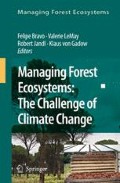The increased concentrations of greenhouse gases in the atmosphere are one of the most severe current environmental problems. The annual atmospheric increase of carbon is estimated to be 3.2Pg (IPCC, 2001, p. 190). In comparison, the annual harvest of roundwood is about 3.5 billion cubic meters (FAO, 2006) and contains approximately 0.8 Pg carbon in roundwood (assuming 0.23 Mg C/m3) and is, hence, significant also for the global carbon balance. The estimated amount of carbon in forested areas is approximately 650–1,200Pg (House et al., 2003; Grace, 2004; FAO, 2006), most of which is located in forest soils. Recent aboveground biomass estimates are between 257 Pg (Kauppi, 2003) and 359 Pg (IPCC, 2001). Given the large amounts, even a small proportional change is influential.
Access this chapter
Tax calculation will be finalised at checkout
Purchases are for personal use only
Preview
Unable to display preview. Download preview PDF.
References
FAO (2001). Global forest resources assessment 2000. Main report. FAO Forestry Paper 140. Food and Agriculture Organization of the United Nations, Rome, 479 p.
FAO (2006). Global forest resources assessment 2005. Main report. FAO Forestry Paper 147. Food and Agriculture Organization of the United Nations, Rome, 320 p.
FAOSTAT Statistics (2006). [Referenced 15.11.2006] http://faostat.fao.org/site/513/DesktopDefault .aspx?PageID=513.
Global Forest Resources Assessment (2005). FAO Forestry Paper 147. Food and Agriculture Organization of the United Nations, Rome, 320 p.
Goodale, C.L., Apps, M.J., Birdsey, R.A., Field, C.B., Heath, L.S., Houghton, R.A., Jenkins, J.C., Kohlmaier, G., Kurz, W., Liu, S., Nabuurs, G.-J., Nilsson, S. and Shvidenko, A.Z. (2002). Forest carbon sinks in the Northern Hemisphere. Ecological Applications 12(3):891–899.
Grace, J. (2004). Understanding and managing the global carbon cycle. Journal of Ecology 92:189–202.
Gustavsson, L., Pingoud, K. and Sathre, R. (2006). Carbon dioxide balance of wood substitution: Comparing concrete and wood-framed buildings. Mitigation and Adaptation Strategies for Global Change 11:667–691.
Hoen, H.F. and Solberg, B. (1994). Potential and economic efficiency of carbon sequestration in forest biomass through silvicultural management. Forest Science 40(3):429–451.
House, J.I., Prentice, I.C., Ramankutty, N., Houghton, R.A. and Heimann, M. (2003). Reconciling apparent inconsistencies in estimates of terrestrial CO2 sources and sinks. Tellus B 55(2), 345–363.
Hynynen, J., Ahtikoski, A., Siitonen, J., Sievänen, R. and Liski, J. (2005). Applying the MOTTI simulator to analyse the effect of alternative management schedules on timber and non-timber production. Forest Ecology and Management 207:5–18.
Hyvän metsänhoidon suositukset (2001). Metsätalouden kehittämiskeskus Tapio. Helsinki, 95 p.
IPCC(2001). In: Houghton, J.T., Ding, Y., Griggs, D.J., Noguer, M., van der Linden, P.J., Dai, X., Maskell, K., Johnson, C.A. (eds.). Climate change 2001 The scientific basis Contribution of the Working Group I to the Third Assessment Report of the Intergovernmental Panel on Climate Change. Cambridge University Press Cambridge 881.
Kauppi, P.E. (2003). New, low estimate for carbon stock in global forest vegetation based on inventory data. Silva Fennica 37(4):451–457.
Kauppi, P.E., Ausubel, J.H., Fang, J., Mather, A.S., Sedjo, R.A. and Waggener, P.E. (2006). Returning forests analyzed with the forest identity. Proceedings of the National Academy of Sciences of the United States of America 103(46):17574–17579.
Lippke, B., Wilson, J., Perez-Garcia, J., Bowyer, J. and Meil, J. (2004). CORRIM: Life-cycle environmental performance of renewable building materials. Forest Products Journal 54(6):8–19.
Liski, J., Pussinen, A., Pingoud, K., Mäkipää, R. and Karjalainen, T. (2001). Which rotation length is favourable to carbon sequestration? Canadian Journal of Forest Research 31(11):2004–2013.
Manriquez, A.C. (2002). Carbon sequestration in the Pacific Northwest: A model. Master of Science thesis, University of Washington, Washington, USA, 167 p.
Niles, J.O. and Schwarze, R. (2001). The value of careful carbon accounting in wood products. Editorial. Climatic Change 49:371–376.
Oliver, C.D. (1992). A landscape approach: Achieving and maintaining biodiversity and economic productivity. Jouranl of Forestry 90:20–25.
Perez-Garcia, J., Lippke, B., Comnick, J. and Manriquez, C. (2005a). An assessment of carbon pools, storage, and wood products market substitution using life-cycle analysis results. Wood and Fiber Science 37:140–148.
Perez-Garcia, J., Lippke, B., Briggs, D., Wilson, J.B., Bowyer, J. and Meil, J. (2005b). The environmental performance of renewable building materials in the context of residential construction. Wood and Fiber Science 37:3–17.
Petersen, A.K., Gobakken, T., Hoen, H.F. and Solberg, B. (2004). Avoided greenhouse gas emissions when forest products substitute competing materials - effect on carbon account and optimal forest management. A case study of Hedmark County in Norway. Scandinavian Forest Economics 40:113.
Petersen, A.K., Gobakken, T., Hoen, H.F. and Solberg, B. (2005). Increasing the carbon benefit from a forest area–optimal forest management and cost-effectiveness. A case-study from Hedmark County in Norway. In: Petersen-Raymer, A.K. (ed.). Modelling and analysing climate gas impacts of forest management. Ph.D. thesis 2005:11, Paper V. Norwegian University of Life Sciences, Department of Ecology and Natural Resource Management, Norway.
Pingoud, K. and Lehtilä, A. (2002). Fossil carbon emissions associated with carbon flows of wood products. Mitigation and Adaptation Strategies for Global Change 7(1):63–83.
Pingoud, K., Pohjola, J., Valsta, L. and Karttunen, K. (2006). Tapaustarkastelu: metsien ja puutuotteiden yhdistetty vaikutus, pp. 17–29. In: Valsta, L., Ahtikoski, A., Horne, P., Karttunen, K., Kokko, K., Melkas, E., Mononen, J., Pingoud, K., Pohjola, J., Uusivuori, J. (eds.). Puu ilmastonmuutoksen hillitsijänä. Loppuraportti. Helsingin yliopisto, Metsäekonomian laitos. ISBN 952–10-3022–4. Yliopistopaino, Helsinki, 57 p.
Valsta, L., Sedjo, R.A., Pingoud, K. and Gustavsson, L. (2005). Forests and forest products in climate change mitigation. International Forestry Review 7(5):72.
Author information
Authors and Affiliations
Editor information
Editors and Affiliations
Rights and permissions
Copyright information
© 2008 Springer Science + Business Media B.V
About this chapter
Cite this chapter
Valsta, L., Lippke, B., Perez-Garcia, J., Pingoud, K., Pohjola, J., Solberg, B. (2008). Use of Forests and Wood Products to Mitigate Climate Change. In: Bravo, F., Jandl, R., LeMay, V., von Gadow, K. (eds) Managing Forest Ecosystems: The Challenge of Climate Change. Managing Forest Ecosystems, vol 17. Springer, Dordrecht. https://doi.org/10.1007/978-1-4020-8343-3_8
Download citation
DOI: https://doi.org/10.1007/978-1-4020-8343-3_8
Publisher Name: Springer, Dordrecht
Print ISBN: 978-1-4020-8342-6
Online ISBN: 978-1-4020-8343-3
eBook Packages: Biomedical and Life SciencesBiomedical and Life Sciences (R0)

